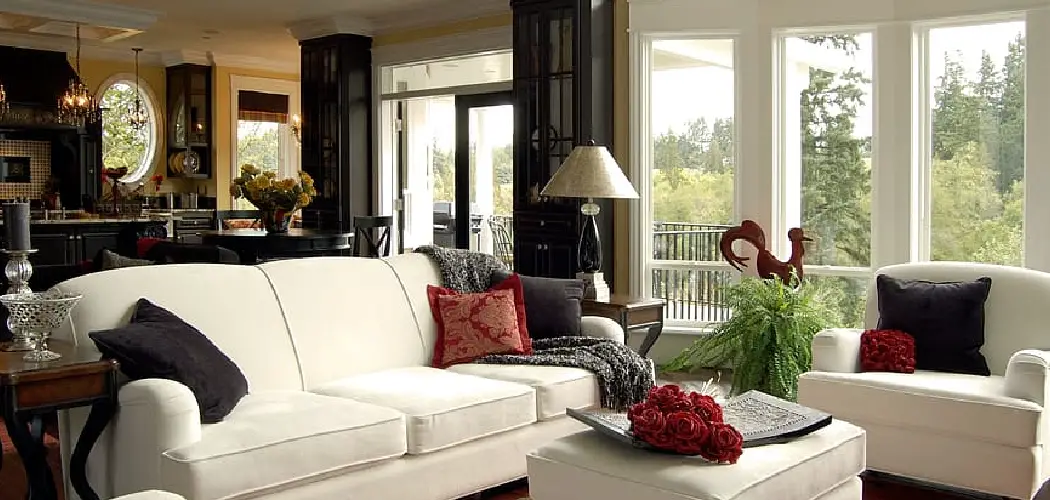Do you have a small living room that’s begging for a cozy, stylish new look? If so, arranging a couch and loveseat can be an effective way to create the perfect visual balance. However, it’s easy to feel overwhelmed when you’re tackling such an important task in a limited space.
So if you want helpful tips on how best to arrange your furniture for maximum impact in a small living room, read on! With our guidance and advice – not to mention some elbow grease – you’ll soon turn your compact space into something fit for magazine covers.
So, keep on reading this article to learn more about how to arrange a couch and loveseat in a small living room.
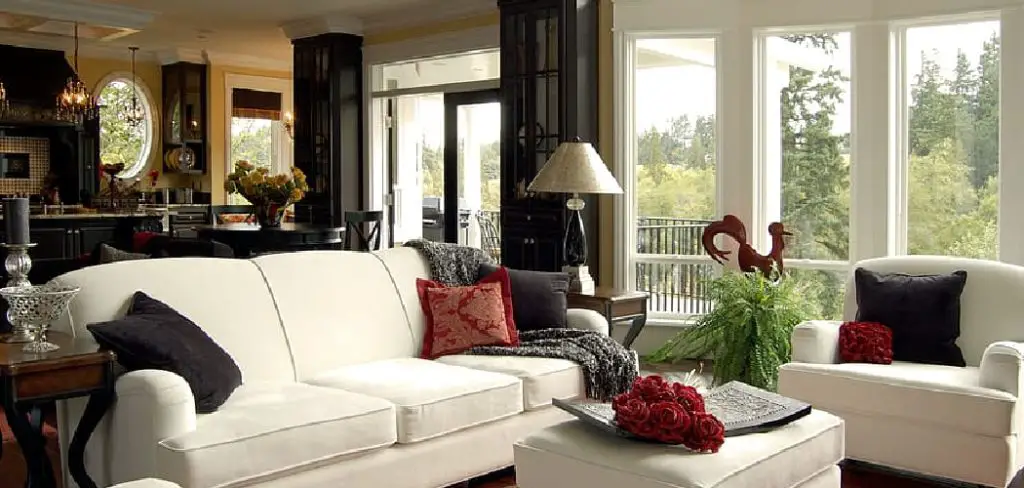
What is Loveseat?
A loveseat is a smaller version of the traditional couch. It’s usually two-seat furniture that measures between 48 to 60 inches in length, perfect for small living rooms. Although it seats fewer people than its larger counterpart, what this piece lacks in size it makes up for with style and comfort.
Needed Tools
Given below are the tools that you will need to arrange your couch and loveseat in a small living room:
- Tape Measure
- Pen/Pencil
- Level
- Furniture Pads
11 Step-by-step Guidelines on How to Arrange a Couch and Loveseat in a Small Living Room
Step 1: Measure Your Room
Before you buy any furniture, measure the length and width of your living space to determine what pieces will comfortably fit. This will ensure you’re not overwhelmed with pieces that are too large for the room. It’s especially important to measure your room if you plan on fitting furniture through a tight doorway or hallway.
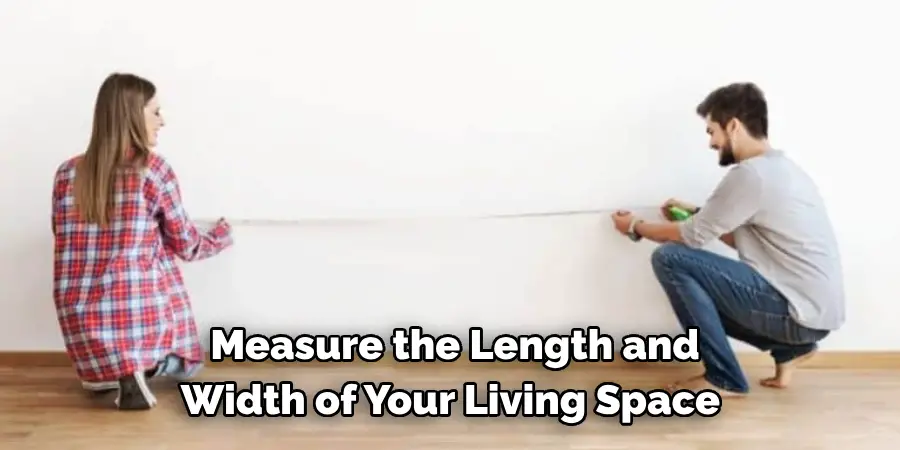
Step 2: Consider Your Style
Choose the style of your couch and loveseat based on the type of look you want for your living space. A contemporary design with sleek lines in neutral colors provides a timeless look, perfect for small spaces that need versatility. But if you want a more retro vibe, consider adding bright colors and unique patterns for a playful atmosphere. This can help add personality and charm to the room.
Step 3: Place the Couch First
It’s best to place your larger piece, the couch, in the room first before adding other furniture. Put it against a wall for a more traditional look, or in an open area if you want to create a modern feel. This will give you more options for arranging the rest of your room. It’s also important to note that the couch should fit proportionately in the space and divide it into two separate areas. This allows for an intimate seating area that’s cozy and inviting.
Step 4: Understand Your Space
Once the couch is in place, determine how much room you have left to move around and fit your loveseat. Depending on the size of your living space, a loveseat can be placed perpendicularly to your couch or at an angle for a more casual feel. But if you’re tight on space, try adding two chairs that can be moved around the room easily. It’s also a great solution for when you have extra guests over.
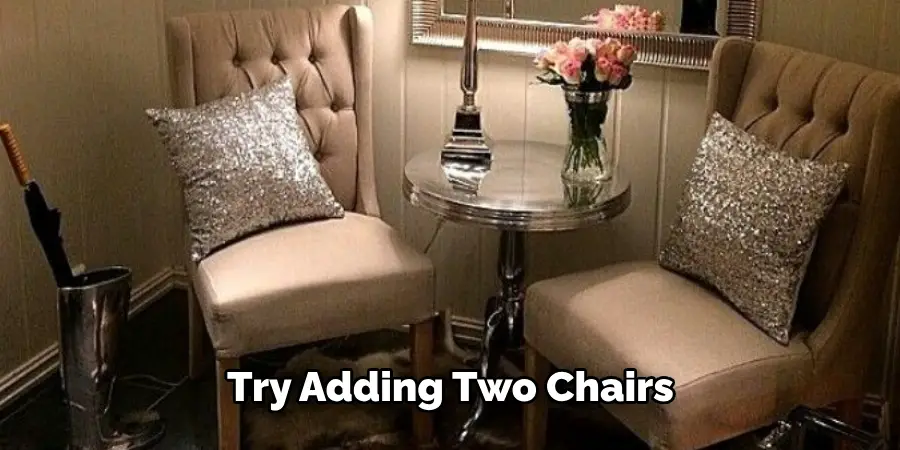
Step 5: Position the Loveseat
Place the loveseat about 2 feet away from your couch for an ideal seating arrangement. A small living room may require a tighter distance between furniture to provide a more intimate feel. It’s also a great way to maximize seating within the same small area. Just be sure to leave enough space in between for easy access when entertaining guests and moving around the room. Here is the Markdown content with additional details added:
Step 6: Create a Balance
When arranging the pieces, keep in mind that there should be equal space on each side of the room to create balance. Place two chairs, an ottoman or a coffee table to fill in any empty spaces. It’s important to consider the size of your furniture and accessories in relation to the space so as not to overcrowd or overpower the room. But it’s also important to remember that arranging furniture doesn’t always have to be symmetrical. It’s a great way to create interest and personalize the room.
Step 7: Add Accent Pieces
An end table, floor lamp or entertainment center can help provide visual interest and tie the entire room together. If space is tight, look for pieces that are lightweight and easy to move around. But don’t forget to use the walls for added design elements like shelves and artwork. This will help create a sense of depth in your small living space.
Step 8: Accessorize
Accessorizing your living room can add the final touch to your design. Throw pillows, artwork, and rugs are all great options for adding color and texture to the space. You can also use plants to add life and vibrancy to the area. It’s also a great way to create a more inviting atmosphere.
Step 9: Rearrange
Don’t be afraid to rearrange furniture to find the best fit for your living room. Even small changes can make a huge difference, so play around with different layouts until you get it just right. You may find that a diagonal placement works best for your furniture or you can opt for an L-shape design. Even switching the loveseat and couch to opposite walls can create the perfect setting.

Step 10: Step Back
When the furniture is in place, take a step back to assess the entire look of the space. This will help you identify any gaps or mismatched piece sizes that need to be addressed. If all looks good, move on to the next step. It’s best to stand at least 10 feet away from the furniture to get an accurate idea of how it looks in the room.
Step 11: Add Your Personal Touch
Finally, add your own personal touches for a custom look that reflects your style. Whether it’s family photos or framed art, these details will transform the room into a cozy and inviting space you can enjoy for years to come. It’s all about finding the perfect balance between style and comfort! Always remember to focus on the essentials when arranging a couch and loveseat in a small living room, so you can make the most of your space without compromising on style.
These helpful tips on how to arrange a couch and loveseat in a small living room will help you create the perfect look that fits your space. With the right furniture, accessories, and creativity, you can transform your living room into a stylish and comfortable haven.
Add an area rug to bring all of the pieces together and create an inviting ambiance. Choose colors that complement the furniture and accessories, but don’t be afraid to add some contrast. A rug with a bold pattern or bright color can bring energy and vibrancy to the room for a modern look.
Tips for Maximizing Space in A Small Living Room
1. Use Multi-Functional Furniture:
Opt for pieces that can serve multiple purposes, such as a storage ottoman or a coffee table with built-in shelves.
2. Utilize Wall Space:
Install floating shelves or wall-mounted cabinets to free up floor space and add storage options.
3. Consider Folding Furniture:
Look for folding chairs or tables that can be easily stored away when not in use, allowing for more open space.
4. Think Vertical:
Use tall bookcases or shelving units to maximize storage without taking up too much floor space.
5. Use Mirrors:
Mirrors can create the illusion of a larger room and reflect natural light, making the space feel brighter and more spacious.
6. Don’t Overcrowd:
Avoid overcrowding the room with unnecessary furniture or accessories. Stick to only essential pieces to maintain an open and airy feel.
7. Keep It Simple:
Stick to a simple color scheme and avoid busy patterns in small living spaces to create a clean and cohesive look.
8. Use Light Colors:
Lighter colors can make a space feel bigger and brighter, so opt for light-colored furniture and walls.
9. Use Furniture with Legs:
Furniture with legs can create the illusion of more space by allowing light to flow underneath and giving the room a more open feel.
10. Declutter Regularly:
Regularly decluttering and organizing your small living room will help keep it feeling spacious and clutter-free.
Remember, the key to arranging furniture in a small living room is finding a balance between functionality and style. With these tips, you can create a cozy and inviting space without sacrificing on comfort or design. Happy decorating!
The Benefits of Using Multifunctional Furniture in A Small Living Room
Multifunctional furniture is not only space-saving but also adds versatility to a small living room. It allows for more storage options and can serve multiple purposes, making it perfect for maximizing space in a small area. Some common multifunctional furniture pieces include:
- Storage ottomans: These can be used as extra seating for a coffee table and also provide hidden storage.
- Nesting tables: These smaller tables can be stored underneath each other when not in use, saving space in a small living room.
- Sofa beds: Perfect for overnight guests, a sofa bed can serve as both seating and a bed without taking up extra space.
- Wall-mounted desks: Ideal for creating a home office in a small living room, these desks can be folded away when not in use.
- Convertible dining tables: These can be used as a small coffee table or expanded to seat more people for meals.
Using multifunctional furniture allows you to have all the necessary pieces in your living room without overcrowding the space. It also adds functionality and versatility, making your small living room more practical and efficient. So, next time you’re shopping for furniture, consider opting for pieces that can serve multiple purposes. Your small living room will thank you!
Creating a Cohesive Design with Different Styles of Couches and Loveseats
1. Stick to a Common Color Palette:
Choose a color scheme that complements both the couch and loveseat, whether it’s neutral tones or bold colors. This will tie the two pieces together visually.
2. Mix and Match Patterns:
Don’t be afraid to mix and match different patterns on your couch and loveseat as long as they have a common color or theme. This will add visual interest and create a cohesive look.
3. Add Accent Pillows:
Use accent pillows in coordinating colors to tie the two pieces together and create a cohesive design.
4. Use Similar Materials:
If you have a leather couch, consider getting a loveseat with leather details to create a sense of harmony between the two pieces.
5. Incorporate Different Textures:
Adding different textures, such as a plush couch and a sleek loveseat, can add visual interest and create a cohesive design.
6. Use Common Accessories:
Incorporate similar accessories, such as throw blankets or side tables, to tie the two pieces together and create a cohesive look.
7. Stick to One Style:
If you have a modern couch, opt for a modern loveseat to create a cohesive and streamlined look.
8. Mix Different Sizes:
Don’t be afraid to mix different sizes of couches and loveseats, such as a small sofa and a large loveseat, to add visual interest and create a cohesive design.
9. Consider Proportions:
Make sure the couch and loveseat are proportionate to each other and the size of the room to create a balanced and cohesive look.
10. Add Personal Touches:
Incorporate your personal style into both pieces, whether it’s through throw pillows or decorative accessories, to tie them together and create a cohesive design that reflects your personality.
By following these tips, you can mix and match different styles of couches and loveseats to create a cohesive and personalized design in your living room. Don’t be afraid to get creative and have fun with it! So, whether you prefer a modern or traditional style, you can easily incorporate different pieces to create a unique and cohesive living space.
Frequently Asked Questions
Q. What is the Best Size for a Loveseat in a Small Living Room?
A. The ideal size of a loveseat for a small living room should be between 48 to 60 inches in length. This will help provide comfortable seating without taking u too much space.
Q. What Should I Place in the Middle of My Living Room?
A. A coffee table is a great way to fill the center of your living room and provide a place for snacks or drinks when entertaining guests. If you need more seating, an ottoman can take up less space than traditional chairs and be used as extra seating when necessary.
Q. What is the Standard Distance Between a Couch and Loveseat?
A. The standard distance between a couch and a loveseat is typically 2 feet apart to provide adequate separation and an ideal seating arrangement. Depending on the size of your room, you may need to place them closer together for a more intimate feel.
Q. What Type of Furniture is Right for a Small Living Room?
A. Choose furniture pieces that are lightweight and easy to move around, such as an armless loveseat or sectional couch. An ottoman can provide extra seating without taking up too much space, while accent chairs will add visual interest to the room. For an open-concept living area, a wall-mounted TV or entertainment center can provide the perfect solution for storage and display.
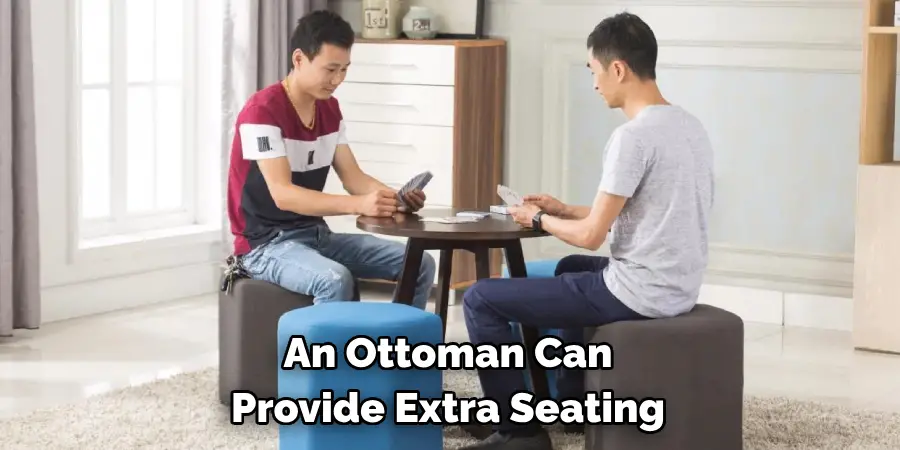
Conclusion
Overall, arranging a couch and loveseat in your small living room can seem like a difficult task. However, following the helpful tips outlined above can certainly make it easier. Remember to consider the dimensions of the space you have available as well as your own aesthetic preferences before deciding on an arrangement.
It may take some trial and error until you find the setup that works best for your particular room, but don’t be afraid to experiment! Finally, with creativity and patience, you will have a beautiful and functional living room design that fits with all of your furniture and vision. You can create the look you want without sacrificing comfort or style if you follow these simple guidelines on how to arrange a couch and loveseat in a small living room!

